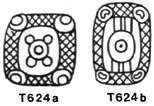| home | First Round Table: Lords of Palenque |

| Michael Coe referred us to the following entry in the Vienna Dictionary: "Escudo, amparo del cuerpo: chimal , pacal " (1972: 97v.). David Kelley (1968: 258) suggests pacal as a phonetic complement of the T624 shield glyph. We believe that pacal was the personal name of our first ruler. In later times other important Palenque personages may either have inherited or adopted the Pacal name. The latest known Palenque inscription, the Carved Initial Series pot from Group 3, contains a pacal glyph group at H4. We will henceforth refer to this first lord of Palenque as Lord Shield Pacal. |
|
PARI editor's note: If this is your first intensive exposure to glyphs, you could do worse than the historical approach courtesy of Linda Schele and Peter Mathews. This paper was certainly part of history in the making in 1974.
And if you are tempted to make inferences herefrom to the current state of glyphic interpretation, again you are in good hands. Schele and Mathews hit the ground running, as it were. Inevitably, though, certain readings were refined with time. For instance, the "propeller" element of T624 above is now read as JANAAB' (some type of flower). Thus, Floyd Lounsbury's groundbreaking reading at the First Palenque Round Table has changed slightly in the following ways: |

| Left glyph, superfix: now read as K'INICH, possibly translated as "sun-faced". |

| Left glyph, main sign: now read as JANAAB'. |

| Right glyph, top (unchanged): a phonetic sign for the syllable pa. |

| Right glyph, center (unchanged): a phonetic sign for the syllable ca (now written ka). |

| Right glyph, bottom (unchanged): a phonetic sign for the syllable la, supplying the final -l. |
|
As Lounsbury demonstrated, the three phonetic glyphs on the right side together read Pa -ca -l . (Pacal — or Pakal as it is written in the current orthography — is Mayan for "shield".) Thus the great ruler of Palenque is currently referred to as K'inich Janaab' Pakal.
Sometimes the flower element is infixed in the glyph for "shield", giving a reading of k'inich janaab' pakal for the single glyph block, as in Palace Tablet P19:

Or the JANAAB' glyph may appear adjacent to the glyph for "shield", as in Palace Tablet C12 (which also has a phonetic complement, la , underneath the shield logograph):

|
| home | First Round Table: Lords of Palenque |